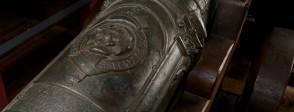Show the students the photograph of the cannon on its reconstructed carriage. Students will readily recognise it as a cannon, so focus on what clues there are in the display about where it was used. Discuss the purpose of the carriage and how it allowed for the recoil from firing. Explore the process of loading and firing such a gun and what the conditions must have been like and the dangers, not least from recoil in confined spaces. Show the students the reconstruction drawing of the Mary Rose and identify where its guns were located – note that this cannon was on the upper deck facing forward. This may be an opportunity to discuss the way in which such ships fought and to contrast the ‘great ships’ such as the Mary Rose which came alongside each other to allow broadsides, fighting from the decks and boarding, and smaller, more manoeuvrable galleys, propelled by oars, which carried heavy guns effective from long range.
At some stage you will want to explore the story of the sinking of the Mary Rose and what the reasons seem to have been for her loss. You might introduce some dramatic irony into such an investigation by explaining that she was built in 1511 and served well and was then refitted around 1536 with more gun ports closer to the waterline. This can then prepare students for one of the likely causes of her sinking. Discuss what the impact of the sinking must have been on those watching – the first 3:30 minutes of the Channel 4 documentary may be useful here - you might consider Henry, the French commander and seamen, the English ordinary seamen on other ships and also mention that the wife of the commander of the Mary Rose was watching from shore. Then discuss why this kind of disaster is significant for an archaeologist – consider the rapidity of the incident which captured the ship at a specific moment, the precise dating, the preservation of a complete set of objects and the possibility of relating all the objects to each other.
Explore what life was like for the men who worked and died on the Mary Rose. There are several different aspects of life that could be picked out including pastimes, dress and physical appearance, social differences, conditions on board ship, eating and drinking, occupations, foreign contacts, religion. Give groups of students different aspects to investigate by browsing through the gallery of artefacts in For the classroom or by printing them out without their captions. How do the students interpret the objects to reach their conclusions? Compare or guide their investigations by supplying the captions given in the gallery. Use the character sketches in Dive In – see For the classroom – to compare the students’ findings. Another way of structuring such an investigation might be to take the characters featured in the BBC article about facial reconstructions and ask the students to browse the gallery of artefacts and select and develop three or four objects that each man might have used.
Look at the cannon in more detail: identify the lion head lifting bosses then use the close-up image to help the students see that other parts are also highly decorated and discuss why this might be the case – why are modern guns entirely functional? Identify the decorative columns, the royal emblems and the locations of the two inscriptions in the photo, then look at the drawing of the crest and inscriptions. Ensure that the students can recognise the features of Henry’s crest: the Tudor rose, the crown and the garter with its familiar motto; you might compare the archer’s bracer in For the classroom. Which of the inscriptions can they make out? They should be able to decipher the makers’ inscription – explain that the gun is referred to as a bastard as it is a non-standard type – why have the makers added their names? Use the translation of the Latin inscription and discuss why Henry also has his ownership marked on the gun and why it is in Latin while the makers’ inscription is in English.
Why was England at war with France in 1545?
The Latin inscription is a useful way of moving from the cannon itself to the political context of the incident in which it was lost. Pick out the three countries mentioned – England, France and Ireland – and investigate Henry’s relationship with each in 1536. Pick out the reference to the Church of England and focus in on the issue of religion and how that defined the relations between England, France and the Holy Roman Empire. This investigation will allow you to study the Field of the Cloth of Gold in 1520 and will culminate in the outbreak of hostilities that led to the attempted French invasion during which the Mary Rose sank.
Use the objects in A bigger picture to introduce the five rulers. Use a map of Europe and the Middle East to locate the area each ruled over and to identify the pressure points. Divide the rulers up among the students and ask them to find out more about them. Use the period of Henry’s reign to lend structure to an investigation into the shifting alliances and relationships among the rulers. Plot the relationships on the map or create a classroom schematic map and use the students themselves to demonstrate how the relationships shifted in particular phases of Henry’s reign.


